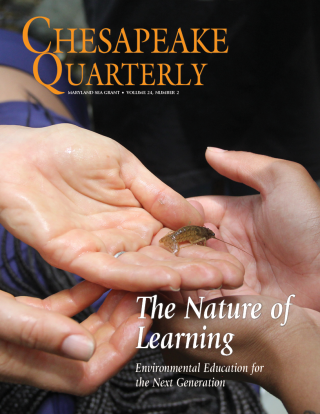Knauss legislative fellowships in Congress help build careers — and they're fun and educational. See our video and fact sheet for details.
The Maryland Sea Grant Bookstore is closed for the winter holidays from Monday, December 15th to Friday, January 5th and will not be taking orders during that time.
R/E-24-Hain
Development and Validation of Novel, Fluorescence-based Tools to Screen For and Identify Urban and Agricultural Sources of Contaminants of Emerging Concern in the Chesapeake Bay
Principal Investigator:
Lee BlaneyStart/End Year:
2018 - 2020Institution:
University of Maryland, Baltimore CountyCo-Principal Investigator:
Ethan HainTopic(s):
- Ecosystems and Restoration
Strategic focus area:
Healthy coastal ecosystemsDescription:
Government agencies have expressed concerns about the potentially negative impacts of contaminants of emerging concern (CECs), such as pharmaceuticals and personal care products, on coastal ecosystems. Few data are currently available on the sources, levels, and spatiotemporal distribution of these contaminants in the Chesapeake Bay. The proposed project will evaluate (1) the use of fluorescent dissolved organic matter (FDOM) components to be used as tracers for urban and agricultural inputs to the Chesapeake Bay and (2) CEC concentrations in Chesapeake Bay water, sediment, and Eastern oyster (Crassostrea virginica). Specifically, we will record fluorescence excitation-emission matrices (EEMs) of water samples collected from the Patuxent and Choptank rivers and other coastal bays/estuaries in the Bay. EEMs from the Patuxent and Choptank rivers will be analyzed using parallel factor analysis (PARAFAC) to identify specific fluorescent components associated with urban and agricultural land use, allowing FDOM source-tracking within the Bay. We will also monitor over 43 antibiotics, 11 estrogenic/androgenic hormones, 12 sunscreen agents, and the conservative wastewater tracer, sucralose, from water samples collected from the Choptank and Patuxent rivers and over 50 sites from the Maryland Department of Natural Resources (MDNR) annual oyster surveys. In total, this plan amounts to over 28,000 individual CEC measurements. Solid-phase extraction liquid chromatography with tandem mass spectrometry (SPE-LC-MS/MS) will be used to measure CECs in water, sediment, and oyster tissue. We will work with outreach mentors from the EPA Chesapeake Bay Program (CBP) and MDNR to share project results with stakeholders and end-users. Ultimately, project activities will not only provide insight into Chesapeake Bay water quality and ecosystem health, but also inform future policy decisions on CECs and protect economic activity associated with the Chesapeake Bay.





